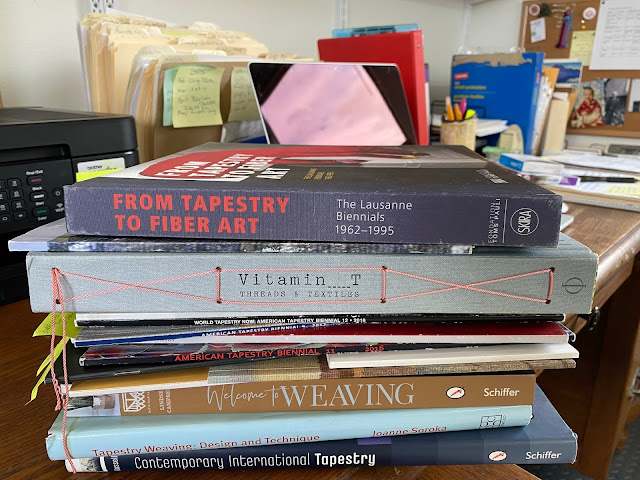I really appreciate the comments of everyone who has written on this topic. It has, not surprisingly, touched a nerve in many of us. As Mandy says,
There are a lot of ways to become an artist. You can learn on your own – study books, journals, take classes and workshops, you can find a mentor who will teach you, become an apprentice or you could go to university for a degree. The truest thing that I know is there is no one choice that will make you feel validated. (my emphasis)
As weaving artists we are prone to self-doubt and insecurity. Making work in our own voice, work that we are proud of, is hard. Tapestry is a challenging medium and many of us find it a lifelong challenge to learn to speak its language fluently. There is no reason for us to make it any harder by dividing ourselves up according to how we have learned, or from whom. My sincerest apologies to anyone who felt offended or put off by anything I said or by anyone's comments in this discussion. My intention has been only to honor everyone's path.
What has emerged for me from our discussion is a kind of consensus that, as Rebecca said in her comment on her BTG post, "there are many paths to our individual goals." Some of us, like Mandy and me, know that we learn best in school, and we have the opportunity and resources to pursue that. For me it was a way for me, in my late 30s, of eliminating a lot of time in trial and error and reinventing the wheel on the path to designing my work (at the time, quilts). Others of us find teachers among practicing artists, and this is the time-honored and very valuable way of learning tapestry. Those who have been trained by James Koehler or Archie Brennan or Jean-Paul Larochette or any of our other legendary tapestry weavers (too many to name them all here) would not trade that experience for anything.
What I'm interested in now is the process of life-long learning: no matter how we started, how do we continue to grow and develop as tapestry weavers (or any other kind of artist)? I jotted down some thoughts:
- Pay attention--to what you are passionate about, what grabs your attention, in the world and in art. Slow down and really look--so often we are scrolling on our devices or doing that slow museum walk past the art on the walls, taking each work of art in in under a minute. When something grabs you, stop and study it. Become curious about why you responded this way. This can give you clues about your own way forward.
 |
| Right now, I'm obsessed with yucca pods and how to portray them in tapestry. |
- Follow through. Honor your work by finding the time, somehow, some way, to make it. Get up early--stay up late--shift your priorities if necessary. Step away from the screens for an hour or a day. When I first started to work as a full-time artist, I adopted the mantra "Pay yourself first." Investment advisors tell us to put money from every paycheck in our savings before we spend it anywhere else. I decided early on to give my first, best hours every day to my artwork, and fit in the chores and errands later. It made a huge difference.
- Stop dissing yourself. In the middle of a project it often looks wonky and weird and it doesn't help to listen to the inner demon who tells you you're no good, have no talent, etc. etc. Just try to have faith, keep at it, finish it and then decide what you think. If nothing else, you will have learned something. No one piece is a referendum on you as an artist.
- Set a goal for yourself. You could decide, all on your own, to make a series or a whole "body of work." You could decide to do a tapestry diary and weave something small every day (and you don't have to start on January 1). Lots of weavers are adapting this approach and doing very cool things. You could work through one of the really good technique books---Rebecca Mezoff's new The Art of Tapestry Weaving, Jean-Pierre Larochette and Yadin Larochette's Anatomy of a Tapestry, or Mette Lise Rössing's book The Thread's Course in Tapestry, just to name a few.
- Recognize that art is a long game. For most of us it takes a lot of time and practice to get good at what we do. Measure your progress against your own previous work rather than against others' work. (This one is hard for me.) Know that there will be fallow periods where it seems like nothing is happening (like maybe this whole past year?). Ride them out; read; keep looking and being attentive. Keep your hands busy doing something, even little woven doodles. Inspiration will come.
 |
| Molly Elkind, Out of My Hands, embroidery, mid-1990s. It's been a long journey from the Amish quilts that first inspired me to tapestry. |
- Seek out chances to learn and grow. Be your own faculty advisor! I don't have to say this to most of you, I suspect. One of the silver linings of the pandemic has been an explosion of great content, much of it free or nearly so, online. We've had a surfeit of great books on tapestry come out in the past year, and more are on the way.



